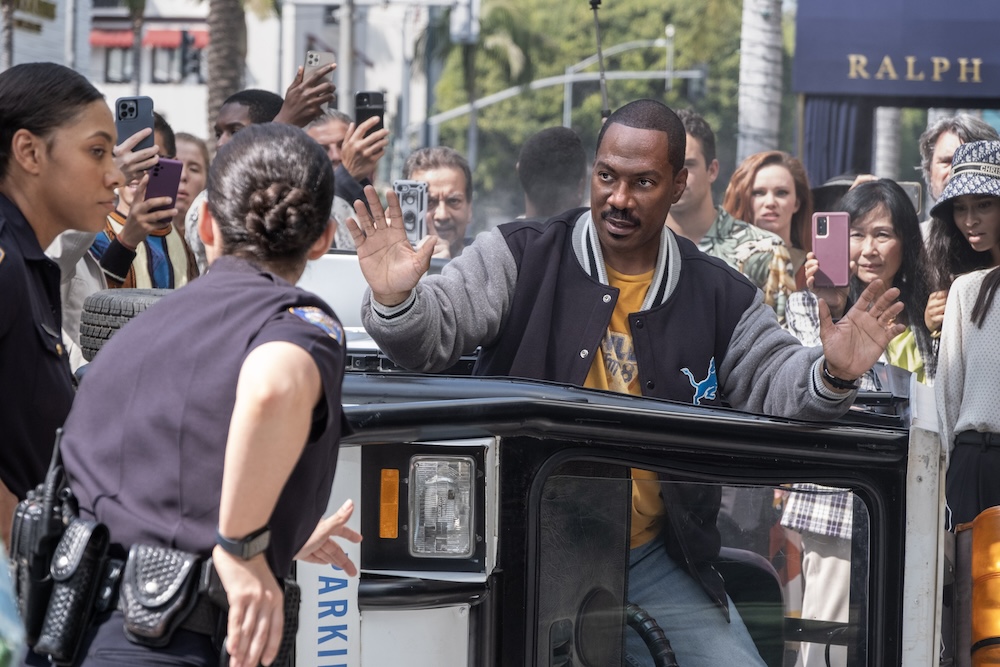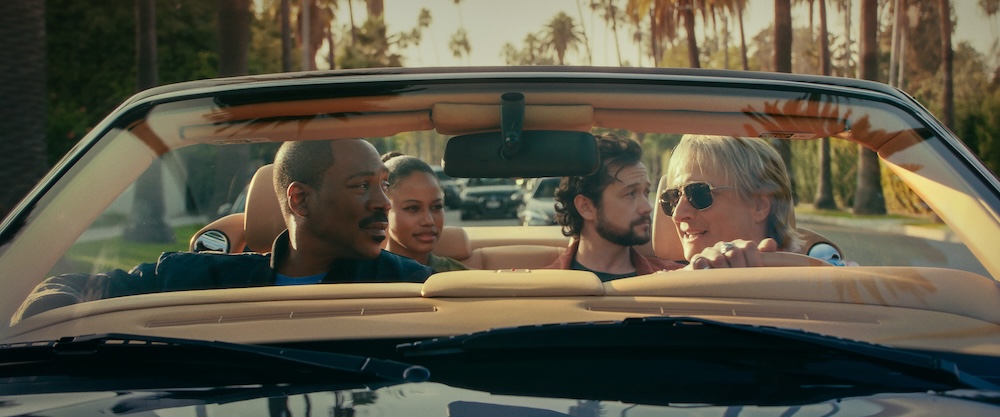-
 play_arrow
play_arrow
Clubalicious Clubalicious Radio
-
 play_arrow
play_arrow
London Calling Podcast Yana Bolder


Hollywood, CA (August 5, 2024)—Look out Beverly Hills: Axel is back! It’s been 40 years since Eddie Murphy first starred as the rule-bending Detective Axel Foley in Beverly Hills Cop. He’s now reprising that role in director Mark Molloy’s debut feature film, Beverly Hills Cop: Axel F, which premiered on Netflix to kick off the July 4 holiday weekend. Sound, the director made clear, would be key in reviving the nostalgic 1980s feel of the original three films.
“From the first shot of the movie, when you see Axel Foley, Mark wanted this feeling of excitement, this readiness to join Axel’s team again,” says Chris Diebold, the film’s supervising sound editor/sound designer/re-recording mixer.
Eddie Murphy isn’t the only returning member of the franchise. On-screen, Judge Reinhold is back as Billy Rosewood, John Ashton as Sergeant Taggart, Paul Reiser as Detective Jeffrey Friedman, and Bronson Pinchot as Serge. Off-screen, rerecording mixer Paul Massey (winner of the 2019 Best Sound Oscar for Bohemian Rhapsody) returned to the faders, 30 years after he mixed Beverly Hills Cop III alongside Scott Millan and Steve Pederson on a custom console with limited automation at Todd-AO Studios in Hollywood.
“Technology has evolved greatly since I started in Hollywood,” Massey notes, acknowledging his own understatement. “Everything was on magnetic film. A lot of the consoles weren’t automated—some were partially automated, just the faders. You’d mix for a week, take a hiatus, and come back trying to get analog recorders to match, and trying to get consoles to perform the same way and have the same settings. It was quite a task.”
This time around, Massey mixed music and dialog while Diebold handled effects at the John Ford Mixing Stage on the Fox Studio Lot in Century City, working from a combination of an AMS-Neve DFC-3D Gemini console (Massey) and an Avid S6 (Diebold). Massey explains, “Both the Howard Hawks and the Ford Stages at the Fox Studio Lot have the option of S6s on both sides, DFCs on both sides, or a split DFC/S6 console combination. It works out really well.
“The main stages at Fox are two of just a few facilities in L.A. with dedicated engineers for each stage,” he continues. “That’s a great luxury and very helpful in terms of us reporting a problem and engineering responding. Bill Stein [Post Production Sound Engineer at Fox Studio Lot] has been on the Ford Stage for many years. He’s an incredible resource, guiding us through all the upgrades and different plugins, maintaining the consoles, the room, and the monitoring, and tuning the room. Tim Gomillion [sound recordist/mix tech] has been there with Bill for several years now. Together, they operate a really solid room.”
Because the film is streaming on Netflix, Massey and Diebold mixed natively in Dolby Atmos, checking downmixes to 5.1 and stereo while monitoring through screen arrays consisting of JBL 15-inch woofers with BMS coaxial drivers amplified as a three-way system, with Meyer Sound surrounds and Meyer 500-HP subwoofers.
“Knowing this was going straight to Netflix, I put a limiter on my master bus that matched the Netflix specs before we started the mix,” says Diebold. “This way, when we did the near-field mix—how most people will hear it—it wouldn’t be outrageously loud; it would translate better and sound closer to the original mix.”

DIALOG IS KING
As an action-comedy, Beverly Hills Cop: Axel F has high-energy sequences with vehicle impacts, crashes, explosions and shootouts, but the comedy lives in the dialog. Those performances—often ad-libbed by Murphy—sit at the heart of the film. “For [producer] Jerry Bruckheimer, dialog is king,” Massey says. “If you can’t understand the dialog, he’s the first one to point it out, which is great. It’s all about the story. Since there was so much emphasis on always making the dialog intelligible, we ended up with a very dynamic mix, but not a wide dynamic range. It maintained a very even flow throughout the entire film, and we didn’t have huge amounts of peaks to deal with when it came to making the two-track mix. The overall internal balance didn’t need to change very much once we’d found our template to make the stereo mix fit within the streaming guidelines.”
In an interview for Netflix’s Tudum (a “behind-the- streams” site for Netflix content), director Molloy remarked that some of the funniest moments are when Murphy is improvising. Adlibbed lines aren’t repeated performances, so it was paramount to preserve production sound mixer Willie D. Burton’s recordings of those comedic deliveries. Massey uses a light touch of noise reduction and EQ during his predubs, he says, not overbaking the dialog with excessive processing. “I like to keep a fairly -full and rich dialog track through predubs to the final mix and only dig in at moments when I really need to, but not too early. Once you’ve dug in, you can’t really dig out.”
Massey’s dialog predubs took place at his Dolby Atmos facility in Ventura on a Harrison MPC5 console, which features onboard dialog processing tools as part of the built-in XTools suite of film-specific plug-ins. He says, “For the final mix at Fox, I have another Harrison rack in a road case that I interface with the DFC so that I have the same equipment. The Harrison and the DFC are my favorite consoles to work on.”
For ADR, Diebold chose ADR Supervisor Sean Massey, his mix partner’s son. “Paul wasn’t on the film yet when I reached out to Sean; I love working with Sean—he’s one of the best,” Diebold says. While there was a decent amount of ADR recorded for the film, the driving scenes, surprisingly, required very little, even in the convertible car. “There was obviously wind, traffic, engine noise, suspension creaks, and so on, but dialog supervisor Susan Dawes and editor Jim Brookshire did a great job cleaning that up,” Massey says. “Those convertible car scenes only had a couple of ADR’d words here and there.”

(SNOW) PLOWING THROUGH THE MIX
A snowplow chase—where a snowplow smashes into cars, and smashes cars into other cars—proved to be one of the most challenging scenes to mix. There’s massive music (composer Lorne Balfe’s score hits hard up front and is then overtaken by Bob Seger’s “Shakedown”), radio communications blare inside the cab, and ATVs race by.
“We went back and forth to find the right balance of effects and music to make it exciting and big,” Diebold explains. “It also had to be fun and quirky, so on the sound design side, whenever they’re inside the cab, we added funny suspension creaks, but the fun truly comes from the music being played really loud.”
Massey ended up using a lot of compression and EQ on the dialog to get it to sit in a very narrow window amid the music and effects in the scene. He recalls: “Everyone wants the music to be loud, and effects to have big moments as well, plus Eddie [Murphy] is laughing and making jokes the whole time. To make it work, I’ll take the music right up to the beginning of the dialog, apply compression, EQ and a little bit of level, and then duck the music around the dialog. Once that’s cleared, Chris can decide how much of the high- and mid-frequency sound effects he needs to subdue slightly to allow the dialog to poke through.”
Paul Massey Leans Hard on These Mixing Tools
It’s a long action sequence that builds over five minutes to a comedic crescendo. Massey and Diebold found that if they mixed something too loud at the beginning, then they’d lose the arc and it would feel flat. “We had to lead the audience through the story, but also through the emotion and danger of the chase up to that comedy moment at the end,” Massey says. “Each mix maneuver required us to then watch the entire scene again to make sure it was still working.”
This was also a sequence that Molloy wanted to sound very ’80s. “That means a really full, really big, really loud, really compressed sound,” Massey explains. “As a first-time director on the mix stage, Mark wanted a lot of things loud all the time. We had to give a bit of guidance as to how to highlight elements in that wall of sound so we could still have a dynamic mix that was intelligible and would fit Netflix’s spec. We got there in the end, and we’re very proud of the mix.”
COME BACK TOMORROW FOR THE CONCLUSION!
Written by: Admin
Similar posts
Recent Posts
- 🎶 New Music: JID, OneRepublic, Morgan Wallen, Post Malone, MarkCutz, Kidd Spin + More!
- Classic Tracks: The Fireballs’ “Sugar Shack”
- Classic Tracks: Arlo Guthrie’s “City of New Orleans”
- Classic Track: k.d. lang’s “Constant Craving”
- Classic Tracks: Waylon Jennings’ “Are You Sure Hank Done It This Way”
Recent Comments
No comments to show.Featured post

Latest posts

🎶 New Music: JID, OneRepublic, Morgan Wallen, Post Malone, MarkCutz, Kidd Spin + More!

Classic Tracks: The Fireballs’ “Sugar Shack”

Classic Tracks: Arlo Guthrie’s “City of New Orleans”

Classic Track: k.d. lang’s “Constant Craving”

Classic Tracks: Waylon Jennings’ “Are You Sure Hank Done It This Way”
Current show
Upcoming shows

Sugar Radio
Robin Schulz
16:00 - 17:00
Swedish Dance Chart
17:00 - 19:00

Stereo Productions
Chus Ceballos
19:00 - 20:00
Hot House Hours
Dave Baker
20:00 - 21:00
Fresh Is Fresh
THIS WEEKS HOTTEST DANCE RELEASES FROM DEE JAY PROMOTIONS
21:00 - 00:00Chart








